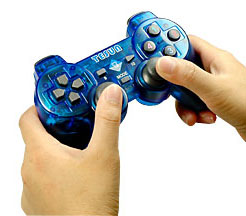
“Under My Thumb” (*)
Whereas once the thumb was a symbol of manipulation and domination in the Rolling Stones song, it is now the cell phone and video game consoles’ turn to be “Under My Thumb.”
The work of Sadie Plant (Warwick University, United Kingdom) has shown that certain parts of the body change themselves to adapt to new technologies, notably the hand and particularly the thumb, which develops great dexterity and endurance, to the detriment of other fingers.
Photo 1: Richard Drew / AP (Site de MSNBC);
Photo 2: Site 4Productions Ltd;
Photo 3: Nintendo;
Photo 4: Ebay Web site.
The first clip below demonstrates how the index finger can be a source of stability and lateral movement while the middle, little and ring fingers assure stability back and forth. The thumb, on the other hand (no pun intended), is used, with surprising quickness, for all forms of movement pertaining to “typing.”
The second clip demonstrates the writing of a text message using the thumb only, while someone else might have performed the task using the index finger only.
What has changed?
Remote control units, used for products such as televisions and sound systems, were sometimes operated by thumb movement, but only from time to time.
It is the frequency of interaction, apparently, that drives morphological change.
Desire for mobility and miniaturization gave birth to portable tools, which integrated all sorts of text messaging systems for communicating across great distances, as well as Internet access.
Thumb action allows for minimum movement thus saving time and improving efficiency.
Therefore, over the mid and long term, are these new ways of interacting to be taken into consideration in interface design and concept?
Yes.
The popularity of cell phones continues to grow and that of video games shows no sign of diminishing, the latter being used as a tool of leisure, training or, as seen recently, for medicinal purposes.
Their use is in constant evolution and the incessant addition of new functions makes for “life” tools that are deemed indispensable for some.
Besides, this type of movement for young users incites change at the design level.
It is therefore important for the design process to take into consideration and adapt to these different types of movement. All the while considering the multi-tasking aspect of things: calling with one hand and smoking with the other, eating or drinking with the left, all the while reading the paper or sending an e-mail with the right hand. When will thumbs get a break?
Do you not think?
There is a downside, however. One must keep in mind that over using the thumb can lead to an emergence of joint/muscle related problems (1) as is the case for increased use of the computer, keyboard and mouse.
The question remains though. Just as long as our hands stay in reasonable shape and do not become marsupial-like, two thumbed stumps (see photo below) then so far so good.
Photo on right: Koala hands and feet. Pittwater Council site
(*) Rolling Stones, 1966. Under My Thumb.
(1) Trackball use, by André Girard.
http://www.andre-girard.com/2006/09/28/effet-dutilisation-prolongee-de-trackball/






0 Comment(s)